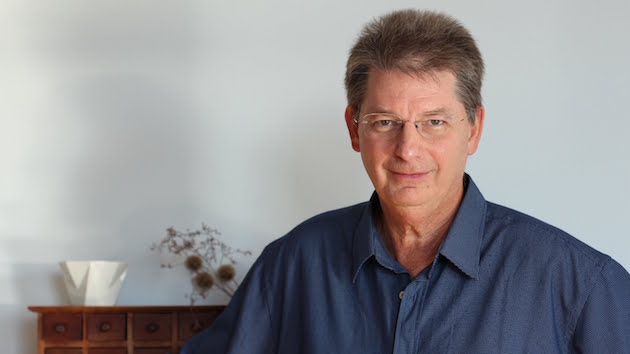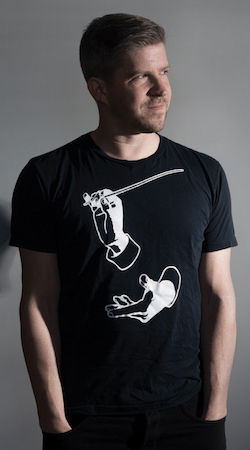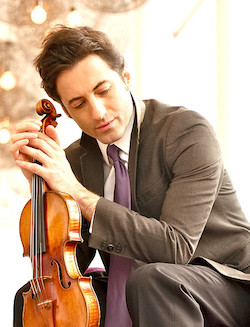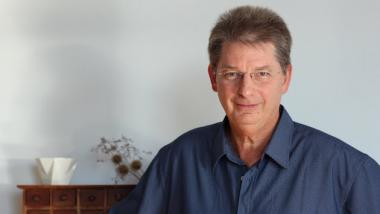
Rain pity on people who arrived late for an early curtain time at Berkeley Symphony’s season opening concert, or those audience members who skipped out precipitously at intermission to be first in line at the Zellerbach Hall concessions bar. They missed the program’s highlights: the world premiere of Crazy Eights & Fractured Symmetries, a new commissioned work by Paul Dresher, and guest soloist Philippe Quint’s violin encore, a spirited and soulful playing of Variation No. 5 from John Corigliano’s Red Violin Caprices.

The program included Erich Korngold’s Violin Concerto with Quint, and Stravinsky’s Petrushka. Music Director Joana Carneiro withdrew from the concert in late September citing personal reasons; Edwin Outwater, the San Francisco Symphony’s Director of Summer Concerts and music director of Ontario’s Kitchener-Waterloo Symphony, led the orchestra with obvious command in her absence.
This was Dresher’s third turn with Berkeley Symphony. His Concerto for Quadrachord and Orchestra had its world premiere in 2012 and introduced to the symphony’s followers the quadrachord, one of several instruments the Bay Area-based composer has invented. Carneiro also led the orchestra in Dresher’s Cornucopia in 2010. The composer’s longstanding relationship with the symphony represents significant investment and shared understanding and has included his mentoring in educational programs and active participation in preconcert talks.
Perhaps due to the multilayered relationship, or simply because a new work carries a degree of tension that, in the hands of skilled musicians, translates into vivid, exciting energy, the approximately 15-minute Crazy Eights was impressive and brought out the night’s finest playing.
Setting aside the program notes that explain symmetrical eight-tone scales and Dresher’s fascination in the work’s second half with “deploying” them in fractured harmonic configurations, the resulting work was suspenseful, at times quirky, and mostly satisfying.
Weighty opening notes that dropped like stones immediately released a mercurial, haunting melody, establishing in the first 60 seconds that gravity is a matter of extreme contrast and drama comes from the unexpected. Moving on from there, the new work was like walking in a dreamland where each corner turned revealed a surprise and transitions existed but felt invisible, like the moment between exhaling and inhaling. If there were any complaints against the work for being less edgy or experimental than the compositions for which Dresher is best-known, they were negated by gorgeous swells, especially a section with strings, harp, and woodwinds that built from serenity to threaten like impending thunderstorms, and jaunty, humorous interjections from Erin Irvine on contrabassoon. Crazy Eights, in one-quarter hour, took a listener on an invigorating trip.

In contrast, Korngold’s 1945 concerto, which featured Grammy nominee Philippe Quint as soloist, promised the sublime, but suffered from over-orchestration that submerged the work’s nuance. At times, despite Quint’s obvious showmanship and agility, especially evident in the concerto’s third movement, it was difficult to separate his playing from its surroundings. Quint’s most expressive moments came in the middle movement “Romanze,” but lost genuineness due to a tendency to broadcast an unnecessary, “here comes the good part, listen closely” message with facial expressions and self-aware body language.
Of course, the on-parade impression dropped entirely during Quint’s crowd-pleasing encore just prior to intermission. Suddenly infinitely human, he played the selection from the film Red Violin with refreshing candor and an innocence bordering sorrow that downplayed his impressive technique.
During intermission there was time to contemplate the concert’s title, “Romance.” Quint’s encore and the other works invited the question: What does comprise romance? How many sugary notes packed into a tiny phrase will feel too sweet; how much pause must be allowed to indicate longing, lust, lingering affection, or lasting devotion? And what is the role of discord or dissonance, which surely must not be left out if excitement and heart-tugging texture or tone are to be maintained?
Stravinsky’s Petrushka had potential to cap the evening with all of these elements, but occasional plodding tempos, two ragged entrances, and conclusions delivered without crispness left the impression that the orchestra was tired or, at the very least, lacked cohesion. The foundation established by the orchestra missed the score’s darkest shadings from the start. A waltz with flute, bassoon, and trumpet, strong presentations by the percussionists, flutist Emma Moon, and trumpeter Scott Macomber, and a forthright performance by principal keyboardist Robin Sutherland — a last-minute loan from the San Francisco Symphony — nearly saved the day. Lacking much of its essential moroseness, however, Petrushka’s underlying tragedy dissipated. Romance, it turns out, requires a touch of grief.

